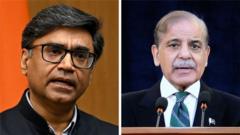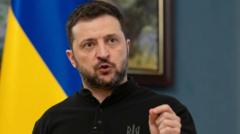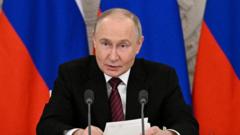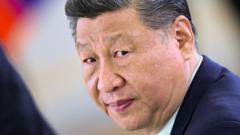Following four explosive days of conflict, India and Pakistan agree to a ceasefire thanks in part to US-led diplomatic interventions, though fragility remains amidst ongoing mutual accusations of violations.
Diplomatic Backchannels Prevent Major Conflict Between India and Pakistan
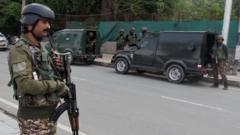
Diplomatic Backchannels Prevent Major Conflict Between India and Pakistan
Amid rising tensions, US mediation plays a crucial role in achieving a ceasefire between the nuclear-armed nations.
In a dramatic turnaround in South Asian geopolitics, US President Donald Trump announced a "full and immediate ceasefire" between India and Pakistan on Saturday, signaling a significant diplomatic success after four days of escalating cross-border hostilities. Experts attribute this breakthrough to the tireless efforts of US negotiators, alongside secretive diplomatic channels involving other regional powers.
Hours after the ceasefire was proclaimed, however, the peace deal faced immediate challenges as both nations exchanged accusations of violations—a clear indication of its tenuous nature. While India alleged "repeated violations" by Pakistan, the latter maintained that it was exercising "responsibility and restraint" amidst the ongoing tensions.
The flare-up originated from a deadly attack on Indian tourists in Kashmir, prompting India to conduct airstrikes within Pakistan's borders, leading to a series of military confrontations, including aerial skirmishes and artillery bombardments. Both countries claimed significant damage inflicted on each other's targets as rhetoric escalated dangerously.
According to Tanvi Madan from the Brookings Institution, a critical point in negotiations came with a call from US Secretary of State Marco Rubio to the Pakistani Army Chief, which might have helped carve out a path toward de-escalation. Pakistan's Foreign Minister, Ishaq Dar, noted that "three dozen countries," including Turkey and Saudi Arabia, were engaged in diplomatic efforts to address the escalating crisis.
This isn't the first time US mediation has been instrumental in defusing tensions between India and Pakistan. Former US Secretary of State Mike Pompeo recounted similar scenarios in his memoirs, highlighting the US's historical role in mitigating conflicts in the region.
In the wake of this recent crisis, Mixed signals from Islamabad suggested a complex strategy of military retaliation intertwined with appeals for dialogue, particularly with the announcement of a National Command Authority meeting regarding Pakistan's nuclear capabilities. Analysts, such as Ashley J. Tellis from the Carnegie Endowment for International Peace, praised Rubio's involvement, stating that "this outcome would not have occurred without his efforts."
Despite initial hesitance, with US Vice President JD Vance declaring it a matter "fundamentally none of our business," the US ultimately took a more active role in facilitating dialogue—an approach distinguished from past interventions.
As tensions simmer below the surface, experts express caution over the ceasefire's longevity. Some critiques center on the hasty nature of the agreement, with foreign policy analysts noting that this rapid arrangement might lack the necessary structural support to maintain long-term peace.
In the backdrop of fluctuating regional dynamics, the US's position as a mediator is affirmed, albeit amid growing complexities involving regional rivalries and the intricacies of nuclear deterrence. The challenge moving forward lies in consolidating this fragile peace agreement into a measurable, enduring resolution for both nations.
Hours after the ceasefire was proclaimed, however, the peace deal faced immediate challenges as both nations exchanged accusations of violations—a clear indication of its tenuous nature. While India alleged "repeated violations" by Pakistan, the latter maintained that it was exercising "responsibility and restraint" amidst the ongoing tensions.
The flare-up originated from a deadly attack on Indian tourists in Kashmir, prompting India to conduct airstrikes within Pakistan's borders, leading to a series of military confrontations, including aerial skirmishes and artillery bombardments. Both countries claimed significant damage inflicted on each other's targets as rhetoric escalated dangerously.
According to Tanvi Madan from the Brookings Institution, a critical point in negotiations came with a call from US Secretary of State Marco Rubio to the Pakistani Army Chief, which might have helped carve out a path toward de-escalation. Pakistan's Foreign Minister, Ishaq Dar, noted that "three dozen countries," including Turkey and Saudi Arabia, were engaged in diplomatic efforts to address the escalating crisis.
This isn't the first time US mediation has been instrumental in defusing tensions between India and Pakistan. Former US Secretary of State Mike Pompeo recounted similar scenarios in his memoirs, highlighting the US's historical role in mitigating conflicts in the region.
In the wake of this recent crisis, Mixed signals from Islamabad suggested a complex strategy of military retaliation intertwined with appeals for dialogue, particularly with the announcement of a National Command Authority meeting regarding Pakistan's nuclear capabilities. Analysts, such as Ashley J. Tellis from the Carnegie Endowment for International Peace, praised Rubio's involvement, stating that "this outcome would not have occurred without his efforts."
Despite initial hesitance, with US Vice President JD Vance declaring it a matter "fundamentally none of our business," the US ultimately took a more active role in facilitating dialogue—an approach distinguished from past interventions.
As tensions simmer below the surface, experts express caution over the ceasefire's longevity. Some critiques center on the hasty nature of the agreement, with foreign policy analysts noting that this rapid arrangement might lack the necessary structural support to maintain long-term peace.
In the backdrop of fluctuating regional dynamics, the US's position as a mediator is affirmed, albeit amid growing complexities involving regional rivalries and the intricacies of nuclear deterrence. The challenge moving forward lies in consolidating this fragile peace agreement into a measurable, enduring resolution for both nations.


